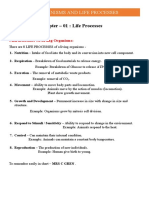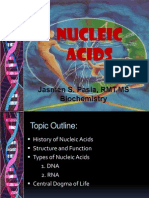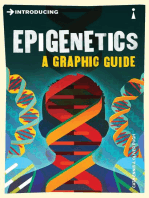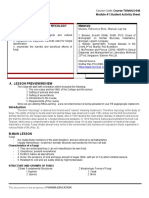0 ratings0% found this document useful (0 votes)
9 viewsDna Code of Life
The document discusses the key components and functions of DNA. It notes that DNA is found in the nucleus and mitochondria of animal cells, and contains the genetic instructions to control cell functioning and hereditary transmission from generation to generation. The DNA molecule has a double-helix structure formed from nucleotides containing phosphate, deoxyribose and nitrogen bases. DNA replication and protein synthesis are also summarized, with DNA replication doubling the genetic material in the cell and protein synthesis using transcription and translation to produce proteins from DNA instructions.
Uploaded by
ndlovusenamile401Copyright
© © All Rights Reserved
Available Formats
Download as PPTX, PDF, TXT or read online on Scribd
0 ratings0% found this document useful (0 votes)
9 viewsDna Code of Life
The document discusses the key components and functions of DNA. It notes that DNA is found in the nucleus and mitochondria of animal cells, and contains the genetic instructions to control cell functioning and hereditary transmission from generation to generation. The DNA molecule has a double-helix structure formed from nucleotides containing phosphate, deoxyribose and nitrogen bases. DNA replication and protein synthesis are also summarized, with DNA replication doubling the genetic material in the cell and protein synthesis using transcription and translation to produce proteins from DNA instructions.
Uploaded by
ndlovusenamile401Copyright
© © All Rights Reserved
Available Formats
Download as PPTX, PDF, TXT or read online on Scribd
You are on page 1/ 9
DNA CODE OF LIFE
o LOCATION OF DNA IN A CELL
o DNA STRUCTURE
o FUNCTIONS OF DNA
o DNA REPLICATION
o DNA VS RNA
o PROTEIN SYNTHESIS
LOCATION OF DNA
There are three places in an cell where DNA is found
• NUCLEUS (nuclear DNA)
• MITOCHONDRIA (mitochondrial DNA)
• CHLOROPLASTS (chloroplastic DNA,In plant cells)
Mitochondria and Chloroplastic DNA are known as EXTRA NUCLEAR
DNA as they found outside the nucleus
IN animal cells it only found in mitochondria and inside the nucleus
STRUCTURE OF DNA
• DNA is made up of monomers called NUCLEOTIDES.Nucleotides are
building blocks of nucleic acids.
• DNA IS DOUBLE HELIX
• NUCLEOTIDE consists of three part
Phosphate (p)
Deoxyribose sugar (S)
Nitrogen base (NB)
• There are four nitrogen base that are held by weak hydrogen bonds
Adenine – Thymine
Guanine – Cytosine
FUNCTIONS OF DNA
• Controls the functioning of the cell
• Controls protein synthesis and formation of proteins , hormones
and enzymes
• Stores hereditary information and transmits this information from
one generation to the next generation
DNA REPLICATION
DNA Replication is the process where by DNA make identical copies
of it self
• OCCURES INSIDE THE NUCLEUS
THE SIGNIFICANCE OF DNA REPLICATION
• DNA replication doubles genetic material
• DNA replication ensure that the daughter cells in mitosis will have
the identical genetic make-up as the parent cell
DNA REPLICATION stage
1. DNA UNWINDS IT SELF
2. THE WEAK HYDOGEN BOND BREAK AND BOTH STRANDS AT AS THE
TEMPLET
3. FREE FLOTING NECLEOTIDES FROM THE NECLEOPLASM JOINS
BOTH STRANDS OF DNA COMPLIMENTAL
4. DNA REWINDS IT SELF
5. TWO IDENTICAL STRANDS OF DNA HAS FORMED
DIFFERENCES BETWEEN DNA AND RNA
DNA RNA
DOUBLE STRANDED SINGLE STRAND
DEOXYRIBOSE RIBOSE
THYMINE(T) URISINE(U)
PROTEIN SYNTHESIS
Protein synthesis it refers to make up of the required protein and
consist of two stages
• Transcription
is the process where by DNA makes mRNA (inside the nucleus)
1. DNA unwinds it self
2. Weak hydrogen bond breaks at the gene point and only one strand
act as the templet
3. Free nucleotides from the nucleoplasm join only one strand of
DNA COMPLEMENTAL, uracil replace thymine
4. MRNA strand has formed and leave the nucleus through nuclear
pores
TRANSLATION
Takes place in the cytoplasm on the RIBOSOME
5.EACH tRNA brings specific amino acid to mRNA. THIS IS CALLED
TRANSLATION.
6.The amino acids are linked together to form a particular protein
this process is controlled by enzymes
Amino acids are linked together by peptide bond
Triples base of mRNA is known as CODONS
Triples base of tRNA is known as ANTCODONS
You might also like
- DNA STRUCTURE-Replication, Transcription, and TranslationNo ratings yetDNA STRUCTURE-Replication, Transcription, and Translation24 pages
- Bio - UNIT 1 - Organisms and Life ProcessesNo ratings yetBio - UNIT 1 - Organisms and Life Processes18 pages
- Dna, Rna, Protein Synthesis and Meiosis g11No ratings yetDna, Rna, Protein Synthesis and Meiosis g1176 pages
- DNA and RNA Introduction and ReplicationNo ratings yetDNA and RNA Introduction and Replication8 pages
- Kami Export - Jane Johnson - DNA Replication RNA and Protien Synthesis.pptxNo ratings yetKami Export - Jane Johnson - DNA Replication RNA and Protien Synthesis.pptx42 pages
- BNAM II Genetics Student Lecture Notes 2024 (1)No ratings yetBNAM II Genetics Student Lecture Notes 2024 (1)88 pages
- Chapter 4A: DNA Replication & Protein SynthesisNo ratings yetChapter 4A: DNA Replication & Protein Synthesis34 pages
- Chapter 11 DNA Strucuture and Replication RNA and Protien Synthesis 2017No ratings yetChapter 11 DNA Strucuture and Replication RNA and Protien Synthesis 201757 pages
- dna-the-code-of-life-notes-2019%20%281%29No ratings yetdna-the-code-of-life-notes-2019%20%281%2912 pages
- Molecular Structure of DNA, RNA, and Proteins DNA Replication and Protein Synthesis (Cenabre, Fortun, Ibal)No ratings yetMolecular Structure of DNA, RNA, and Proteins DNA Replication and Protein Synthesis (Cenabre, Fortun, Ibal)2 pages
- Lecture 5 - Nucleic Acids Dna Genetic Code Transcription TranslationNo ratings yetLecture 5 - Nucleic Acids Dna Genetic Code Transcription Translation16 pages
- ZOO 111 (Lecture 12 - DNA & Protein Synthesis I-II 2020)No ratings yetZOO 111 (Lecture 12 - DNA & Protein Synthesis I-II 2020)45 pages
- DNA LJRNA AND PROTEIN SYNTHESIS (AutoRecovered) (AutoRecovered)No ratings yetDNA LJRNA AND PROTEIN SYNTHESIS (AutoRecovered) (AutoRecovered)30 pages
- Specification Accredited Gcse Gateway Science Suite Biology A j247No ratings yetSpecification Accredited Gcse Gateway Science Suite Biology A j24780 pages
- Cells - The Building Blocks of Life: BiologyNo ratings yetCells - The Building Blocks of Life: Biology11 pages
- Gen Bio Act 1 Prokaryotic and Eukaryotic CellsNo ratings yetGen Bio Act 1 Prokaryotic and Eukaryotic Cells2 pages
- Module#1 - Student Activity Sheet-INTRODUCTION TO MYCOLOGY PDFNo ratings yetModule#1 - Student Activity Sheet-INTRODUCTION TO MYCOLOGY PDF8 pages
- 2-Introduction To Human Anatomy and Physiology PDFNo ratings yet2-Introduction To Human Anatomy and Physiology PDF3 pages
- Cell Structure and Functions: Class 8 NCERT Biology Chapter 4No ratings yetCell Structure and Functions: Class 8 NCERT Biology Chapter 429 pages
- Welcome To Biology 112: Please Pick Up The Course Outline Handout and Blank Half-Sheet of Paper at The Front of The Room!No ratings yetWelcome To Biology 112: Please Pick Up The Course Outline Handout and Blank Half-Sheet of Paper at The Front of The Room!37 pages
- Final Common Neet Grand Test-02 Question Paper Ex - dt.19.04.2024No ratings yetFinal Common Neet Grand Test-02 Question Paper Ex - dt.19.04.202432 pages
- Cambridge Assessment International Education: Biology 9700/42 May/June 2018No ratings yetCambridge Assessment International Education: Biology 9700/42 May/June 201820 pages
- Annales Brainprepa WWW - Touslesconcours.infoNo ratings yetAnnales Brainprepa WWW - Touslesconcours.info11 pages
- Chapter 1 Basic Concepts To Understand PlantsNo ratings yetChapter 1 Basic Concepts To Understand Plants34 pages
- Direct Gene Transfer Methods - Particle Bombardment & Electroporation Method.No ratings yetDirect Gene Transfer Methods - Particle Bombardment & Electroporation Method.24 pages
- DNA STRUCTURE-Replication, Transcription, and TranslationDNA STRUCTURE-Replication, Transcription, and Translation
- Kami Export - Jane Johnson - DNA Replication RNA and Protien Synthesis.pptxKami Export - Jane Johnson - DNA Replication RNA and Protien Synthesis.pptx
- Chapter 11 DNA Strucuture and Replication RNA and Protien Synthesis 2017Chapter 11 DNA Strucuture and Replication RNA and Protien Synthesis 2017
- Molecular Structure of DNA, RNA, and Proteins DNA Replication and Protein Synthesis (Cenabre, Fortun, Ibal)Molecular Structure of DNA, RNA, and Proteins DNA Replication and Protein Synthesis (Cenabre, Fortun, Ibal)
- Lecture 5 - Nucleic Acids Dna Genetic Code Transcription TranslationLecture 5 - Nucleic Acids Dna Genetic Code Transcription Translation
- ZOO 111 (Lecture 12 - DNA & Protein Synthesis I-II 2020)ZOO 111 (Lecture 12 - DNA & Protein Synthesis I-II 2020)
- DNA LJRNA AND PROTEIN SYNTHESIS (AutoRecovered) (AutoRecovered)DNA LJRNA AND PROTEIN SYNTHESIS (AutoRecovered) (AutoRecovered)
- Specification Accredited Gcse Gateway Science Suite Biology A j247Specification Accredited Gcse Gateway Science Suite Biology A j247
- Module#1 - Student Activity Sheet-INTRODUCTION TO MYCOLOGY PDFModule#1 - Student Activity Sheet-INTRODUCTION TO MYCOLOGY PDF
- 2-Introduction To Human Anatomy and Physiology PDF2-Introduction To Human Anatomy and Physiology PDF
- Cell Structure and Functions: Class 8 NCERT Biology Chapter 4Cell Structure and Functions: Class 8 NCERT Biology Chapter 4
- Welcome To Biology 112: Please Pick Up The Course Outline Handout and Blank Half-Sheet of Paper at The Front of The Room!Welcome To Biology 112: Please Pick Up The Course Outline Handout and Blank Half-Sheet of Paper at The Front of The Room!
- Final Common Neet Grand Test-02 Question Paper Ex - dt.19.04.2024Final Common Neet Grand Test-02 Question Paper Ex - dt.19.04.2024
- Cambridge Assessment International Education: Biology 9700/42 May/June 2018Cambridge Assessment International Education: Biology 9700/42 May/June 2018
- Direct Gene Transfer Methods - Particle Bombardment & Electroporation Method.Direct Gene Transfer Methods - Particle Bombardment & Electroporation Method.
















































































































